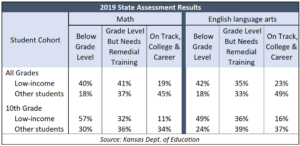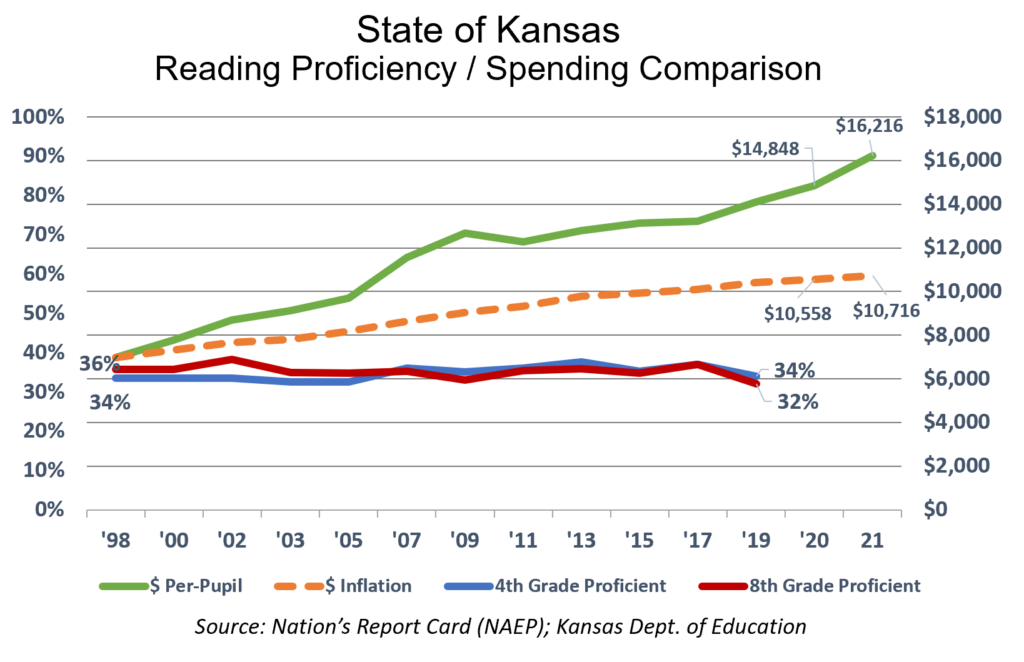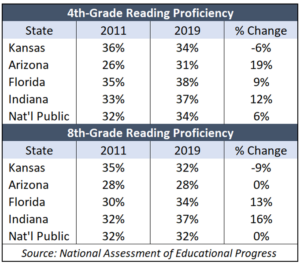The Kansas City Star is notorious for false and misleading claims (see here, here, and here), but even for them, their perfidy on school funding and student achievement is a new low. They made their false and misleading claims to order legislators to keep spending more money with no accountability and to deny low-income students better opportunities.
At-risk students aren’t failing “largely because Kansas spent years underfunding public education;” they are failing because local school boards are not held accountable to spend at-risk funding on at-risk kids; school officials also are not held accountable for improving achievement levels.
A 2019 Legislative Post Audit confirmed what Kansas Policy Institute found in 2015. Most of the more than $400 million allocated to At-Risk students “was used for teachers and programs for all students and did not appear to specifically address at-risk students as required by state law.”
 Legislators gave schools a seven-fold increase in at-risk funding between 2005 and 2019, going from $50 million to $413 million. But since most of that money wasn’t spent as intended, it’s not surprising that achievement for at-risk students remained abysmally low. The 2019 state assessment test shows 40% of low-income kids in all grades tested are below grade level in math; 41% are at grade level but still need remedial training, and only 19% are on track for college and career. Outcomes for students who are not low-income are not good, but significantly better than their low-income peers; just 18% are below grade level and 45% are on track.
Legislators gave schools a seven-fold increase in at-risk funding between 2005 and 2019, going from $50 million to $413 million. But since most of that money wasn’t spent as intended, it’s not surprising that achievement for at-risk students remained abysmally low. The 2019 state assessment test shows 40% of low-income kids in all grades tested are below grade level in math; 41% are at grade level but still need remedial training, and only 19% are on track for college and career. Outcomes for students who are not low-income are not good, but significantly better than their low-income peers; just 18% are below grade level and 45% are on track.
The 10th-grade results are even worse, with 57% of low-income students below grade level in math and only 11% on track for college and career. Similar disparities are found in the English language arts results.
False claim on funding
The Kansas City Star also made consciously false allegations on funding. It isn’t ‘just now’ being restored, and funding wasn’t cut by the Brownback administration as alleged. The Kansas Department of Education shows consistent, record-setting funding increases.
School funding was $12,283 per student in 2011 and it increased every year thereafter except in 2016; a KPERS payment was delayed in 2016, which caused per-student funding to drop $107. Funding in 2017 set another record and KSDE says total funding was $14,848 last year. This year, funding is estimated at $16,216 per student.

School officials didn’t get as much of an increase as they wanted, but that is only a ‘cut’ in government-speak and Star-speak.
Choice helps students in other states
While the Star is campaigning against school choice opportunities for low-income students, states that provide options are showing strong gains.
Following the pioneering leads of Arizona and Florida, Indiana legislators are giving students a fighting chance, and the results are remarkable.
 Between 2011 and 2019 (the latest data available), Indiana students’ reading proficiency improved by 12% in the 4th grade (from 33% proficient to 37%) and by 16% in the 8th grade (from 32% to 37%). Arizona students improved from 26% proficient in the 4th grade to 31%; 8th-grade proficiency held steady at 28%. Students in Florida also improved, going from 35% to 38% proficient for 4th-graders and from 30% to 34% for 8th-graders.
Between 2011 and 2019 (the latest data available), Indiana students’ reading proficiency improved by 12% in the 4th grade (from 33% proficient to 37%) and by 16% in the 8th grade (from 32% to 37%). Arizona students improved from 26% proficient in the 4th grade to 31%; 8th-grade proficiency held steady at 28%. Students in Florida also improved, going from 35% to 38% proficient for 4th-graders and from 30% to 34% for 8th-graders.
But proficiency went backward in Kansas, declining by 6% for 4th-graders and by 9% for 8th-graders. Proficiency fell from 36% to 34% in the 4th grade and 8th-grade results declined from 35% to 32%.
The above results are for all students, but low-income students also had impressive gains. Arizona, Florida, and Indiana students all improved but Kansas students went backward.
KC Star condemns students to a lifetime of underachievement
The Star’s solution – “fix the public schools” – sounds good but an honest look at history shows that that isn’t going to happen.
Joy Eakin, a former Wichita School District Board member, explained in her testimony in support of school choice legislation this year.
“In 2013, I staunchly opposed measures like this bill. I believed we could bring change from the inside and fix these issues for our most vulnerable students. But now I’m here today asking you to pass this bill because I got a good look at the inside of the system.”
The Star and others who want to keep low-income kids trapped in schools that aren’t working for them are tacitly saying that support for the ‘system’ is far more important than getting kids educated.
And their ‘choice’ condemns tens of thousands of students to a lifetime of underachievement.


